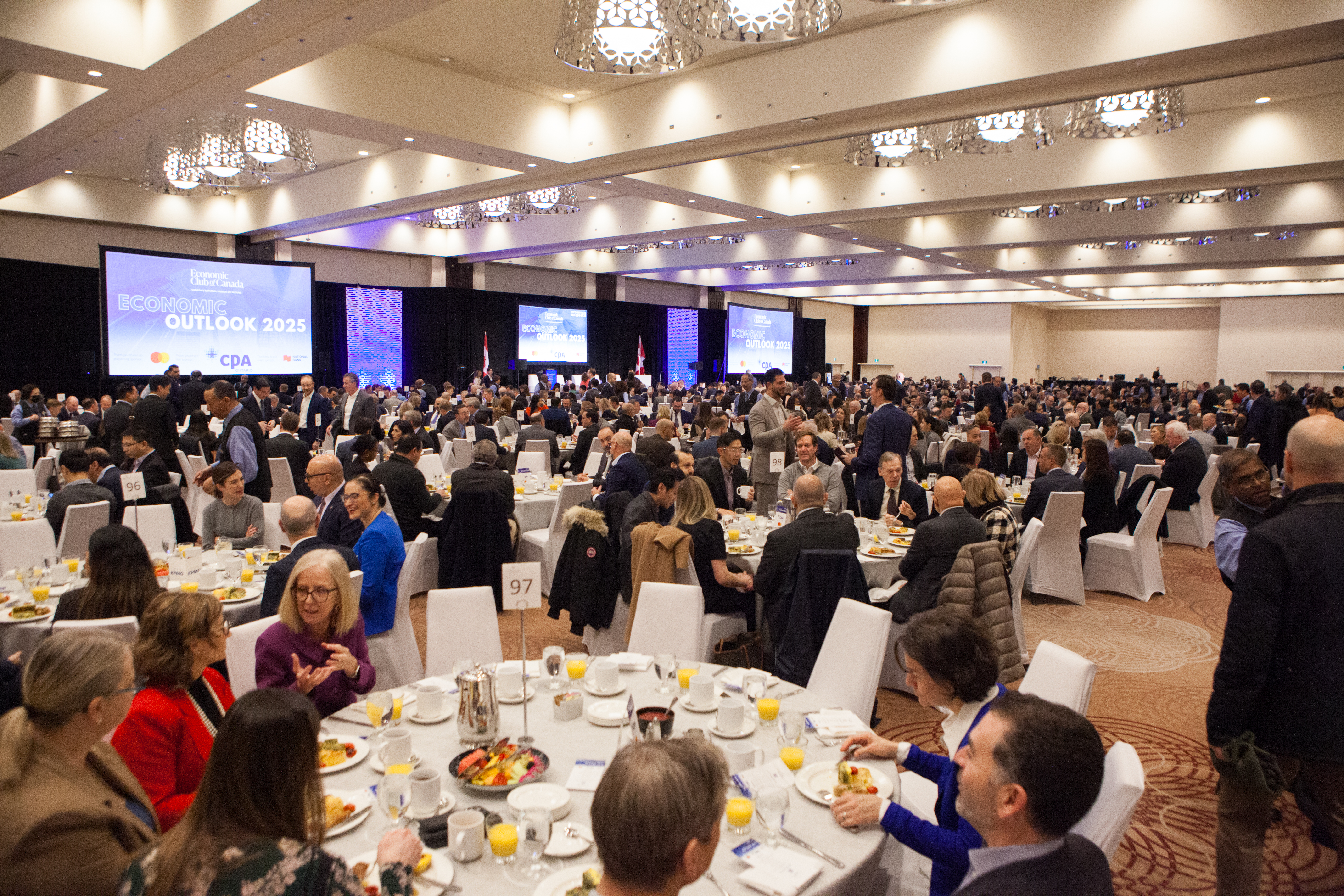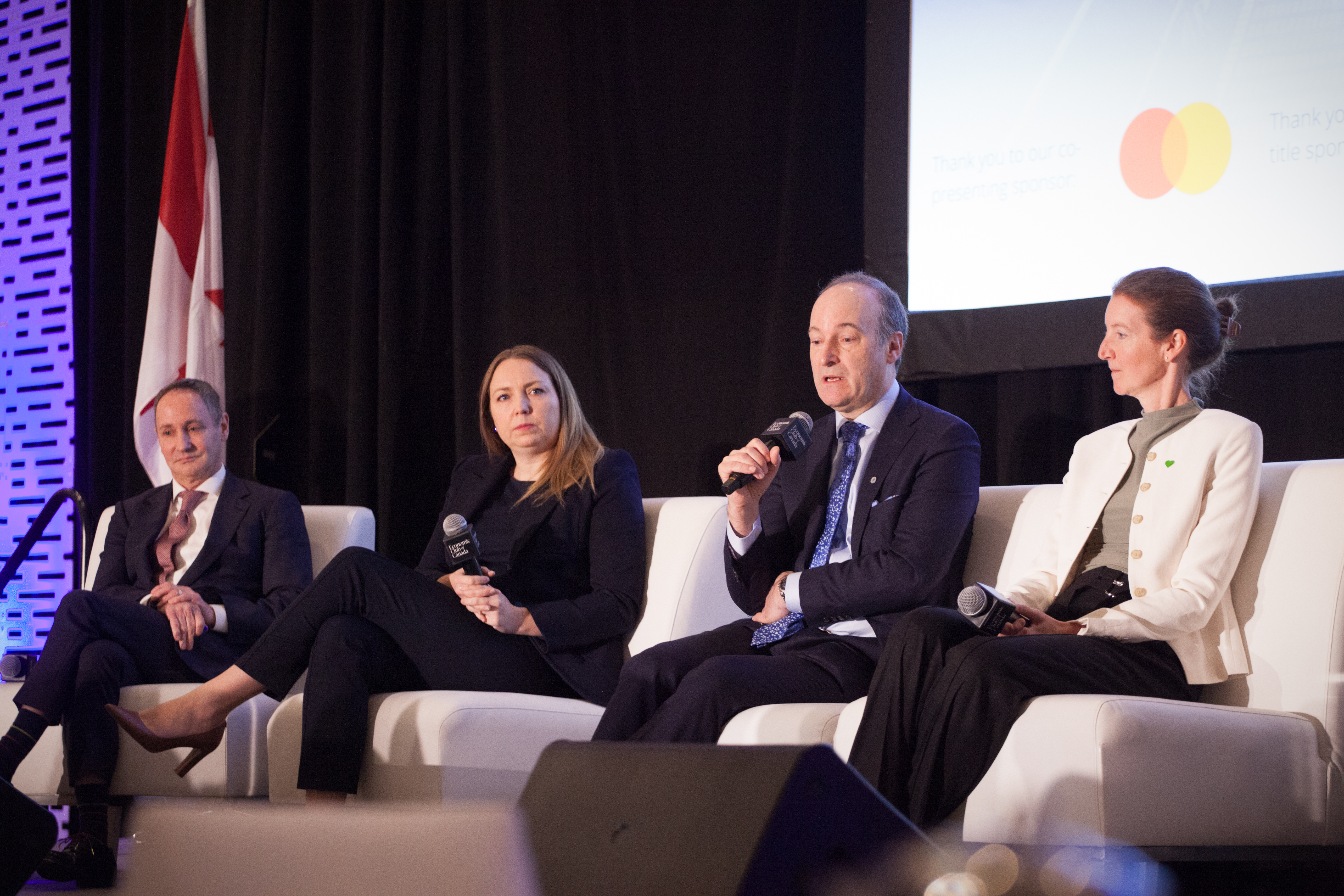What We Heard at The Economic Club of Canada Economic Outlook 2025
Under the dark cloud of tariff threats from the incoming U.S. administration and ongoing political drama in Ottawa, business leaders from across the province gathered at the Sheraton Centre in downtown Toronto for the Economic Club of Canada’s Economic Outlook 2025. In an open and free-wheeling conversation, the top economists from the nation’s leading financial institutions offered their thoughts on what the year ahead holds for the Canadian economy.
In what is shaping up to be a year marked by ongoing policy uncertainty and complexity, CPA Ontario President and CEO Carol Wilding, FCPA, FCA, ICD.D kicked off the conversation by laying out the challenges facing Canadian business and investors, as political paralysis in Ottawa confronts the incoming Trump administration.
Following the opening, Vassy Kapelos, Chief Political Correspondent at CTV News welcomed the panel of economists to offer their perspectives on what Canadians can expect from the year ahead:
- Avery Shenfeld, Managing Director and Chief Economist at CIBC Capital Markets
- Beata Caranci, Chief Economist and Senior Vice President at TD Bank Group;
- Douglas Porter, Chief Economist and Managing Director of Economics at BMO Financial Group;
- Frances Donald, Senior Vice-President and Chief Economist at RBC; and;
- Stéfane Marion, Chief Economist and Strategist at National Bank of Canada

Trump, Trade and Tariffs
The conversation was dominated by President-Elect Donald Trump’s threat to impose a 25% tariff on all goods imported from Canada. The economists agreed that, if an across-the-board tariff is imposed, no one would forecast a “growth year” for the Canadian economy. For perspective, when the previous Trump administration introduced sector-based tariffs on steel and aluminum imports, it cut half a percentage point from Canada’s gross domestic product (GDP). While Avery Shenfeld of CIBC said quantifying the impact of a two-way trade war is next to impossible, all panelists agreed the impact on Canada would be massive given our nation’s trade reliance.
While no one on the panel believed that entering a retaliatory trade war with the U.S. would be advisable, there are options in the short term to help offset the threat. Further cuts to our interest rate and doing more to build up our domestic manufacturing markets were floated, but none of these options would ultimately be enough to offset the economic impact the tariffs would cause. The panel did touch on removing interprovincial trade barriers as a significant option to offset the effects of Trump’s proposed tariffs.
Across the panel, there was broad consensus that the priority for Canada needs to be shoring up our own economy by boosting our productivity and seizing our own competitive advantages.
Strengthening Canada’s Weak Economic “Immune System”
Frances Donald of RBC likened Canada’s economic situation to an immune system. The United States has a “strong immune system,” characterized by relatively high productivity, strong economic growth, and a favourable labour market. As a result, it is in a better position to absorb adverse economic shocks than Canada, which is suffering from a “weak immune system” with weak productivity, a softening labour market, and a lack of competitiveness.
Coupled with the incoming U.S. administration’s proposed policies on deregulation, tax competitiveness and energy production, Canada could see its own position continue to slide relative to the United States.
So, how can we strengthen Canada’s immune system and become more resilient to economic shocks? The panelists pointed out that Canada’s productivity decline has been underway for decades, and the reasons for it are varied. And while there was healthy debate on the stage about where the priorities should lie, there was agreement on a few areas of focus for whoever leads the next government in Ottawa.
Harness Our Natural Resource Advantage: As Beata Caranci of TD Bank Group pointed out, Canada and Greenland have key things in common: they are large northern land masses, they have sparse population density, and they are rich in critical minerals. We can now add to that list an interest in acquisition from President-Elect Trump. This has as much to do with geopolitics as it does with economics. The United States is currently dependent on China for rare earth minerals that are a key component of advanced manufacturing. Critical minerals are a competitive advantage for Canada, and a resource that the United States and the world want.
The same can be said for energy. Thanks to the Trans Mountain pipeline, Canada is now exporting heavy oil down to the Gulf Coast for refining. Combine that with cheap natural gas and electricity, and Canada has an advantage in energy, one that we should be using to attract investment, boost our manufacturing capacity here at home, and export around the world. And boosting manufacturing is a crucial economic opportunity given that manufacturing output is down 30 per cent in Canada since NAFTA was ratified.
But to harness these competitive advantages, Canada will need to re-examine its policy and regulatory landscape, and ensure it is fit for purpose.
Regulatory Reform: The panelists opined that Canada’s environmental regulations – which are growing in number, overlapping, complex, and uncertain – may be acting as a deterrent to investment. While some of these policies are intended to help reduce greenhouse gas emissions, they may be discouraging important projects, including critical mineral and energy infrastructure projects, from getting off the ground. The panelists argued that it may be time to revisit Canada’s suite of environmental policies to see if they are the right mix for this moment in light of global developments including the incoming Trump administration.
Start From Scratch on our Tax Code: The changes to the capital gains inclusion rates, introduced in the 2024 Federal Budget, were called out as an example of a policy that discourages investment and entrepreneurship, including in the innovation economy and the construction sector, where Canada needs to do far more to boost its supply to improve housing affordability. In a larger context, Canada’s tax code is “a mess of credits and subsidies,” according to Beata. Our combined federal and provincial corporate and personal tax rates must be competitive with the United States if we are going to attract investment and prevent the loss of entrepreneurial talent to the US.
The panelists agreed that there have been enough studies and reports looking at the issue of tax competitiveness. Major tax reform needs to be on the top of the priority list in Ottawa and delivered in short order.

What’s In Store for 2025
Doug Porter of BMO pointed out that, with further interest rate cuts coming from the Bank of Canada in the year ahead, there was a scenario where the panel could be talking about potential economic growth in 2025 if it weren’t for the U.S. threat of tariffs. The economists all acknowledged that that Bank of Canada is not done, and there will be more interest rate cuts coming in the next year, with Frances Donald of RBC taking the position that the Bank’s overnight rate lands somewhere between 2 and 2.25%.
But that prediction is dependent on many unknowns. How the situation in Ottawa will play out over the coming months, and whether President-Trump follows through on his threats towards Canada, is still uncertain.
What is certain is that the next year represent a significant challenge to Canada and that we can no longer afford to wait to build a stronger, more resilient economy. The time for action is now.


